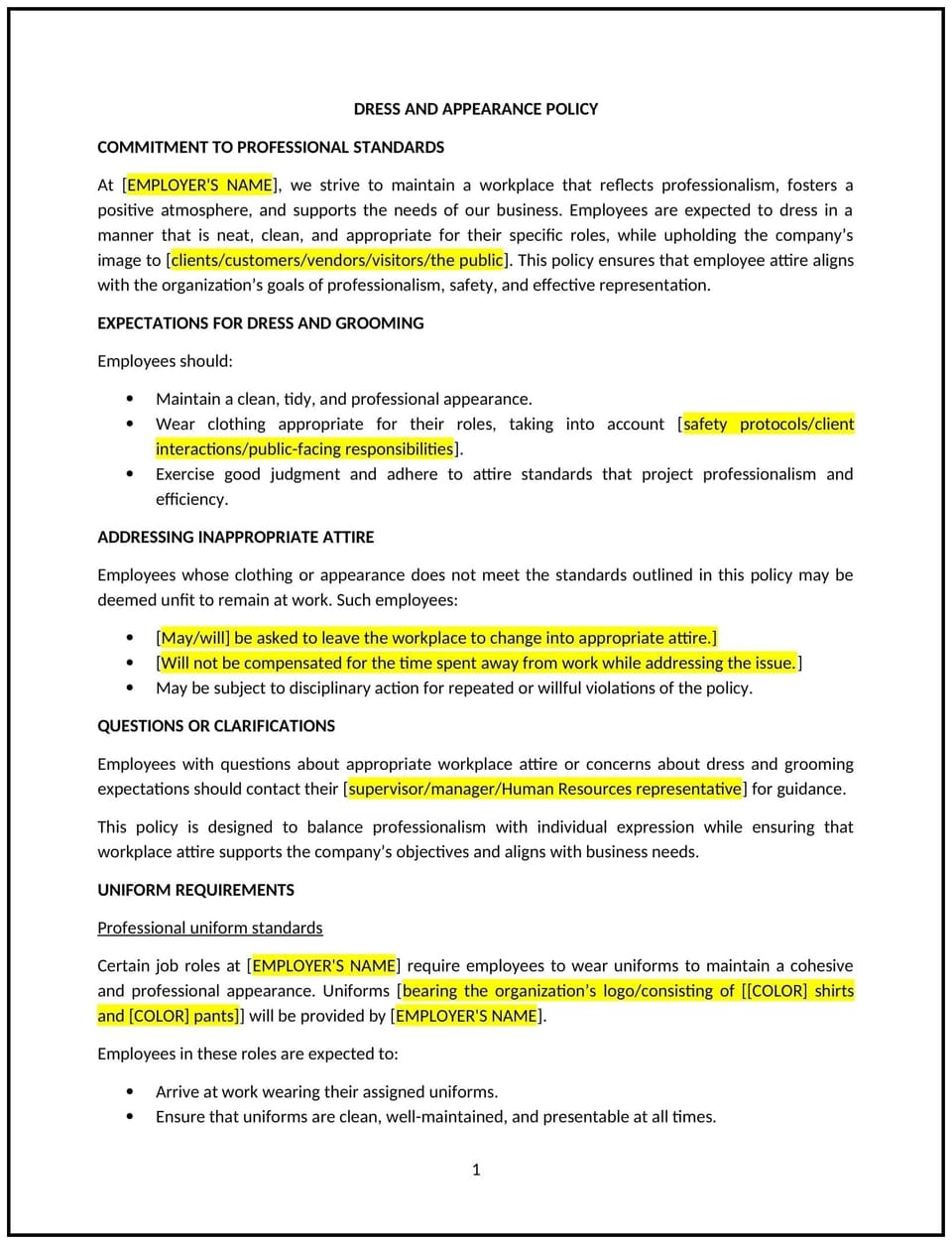Dress and appearance policy (South Carolina): Free template

Dress and appearance policy (South Carolina)
This dress and appearance policy is designed to help South Carolina businesses establish guidelines for employee attire and grooming to maintain a professional and safe work environment. It outlines expectations for workplace dress, including dress codes, uniforms, and hygiene standards.
By adopting this policy, businesses can promote professionalism, ensure safety, and align with general best practices for workplace presentation.
How to use this dress and appearance policy (South Carolina)
- Define dress code: Specify acceptable attire, such as business casual, formal wear, or uniforms, depending on the workplace.
- Address safety requirements: Outline any safety-related dress requirements, such as protective gear or closed-toe shoes.
- Set grooming standards: Provide guidelines for personal hygiene and grooming to maintain a professional appearance.
- Include exceptions: Clarify any exceptions to the dress code, such as casual Fridays or special events.
- Train employees: Educate staff on the policy and their responsibilities for adhering to it.
- Review and update: Assess the policy annually to ensure it aligns with evolving business needs and workplace standards.
Benefits of using this dress and appearance policy (South Carolina)
This policy offers several advantages for South Carolina businesses:
- Promotes professionalism: Ensures employees present themselves in a manner that reflects positively on the business.
- Enhances safety: Reduces workplace hazards by requiring appropriate attire, such as protective gear.
- Aligns with best practices: Provides a structured approach to managing workplace appearance.
- Builds customer trust: Demonstrates a commitment to maintaining a professional and respectful work environment.
- Supports consistency: Ensures all employees follow the same guidelines for dress and appearance.
Tips for using this dress and appearance policy (South Carolina)
- Communicate the policy: Share the policy with employees and include it in the employee handbook.
- Provide training: Educate staff on the policy and their responsibilities for adhering to it.
- Monitor adherence: Regularly review employee attire to ensure compliance with the policy.
- Address issues promptly: Take corrective action if dress code violations occur.
- Update regularly: Assess the policy annually to ensure it aligns with evolving business needs and workplace standards.
Q: How does this policy benefit businesses?
A: This policy promotes professionalism, enhances safety, and aligns with best practices by establishing clear guidelines for employee dress and appearance.
Q: What types of attire are typically included in a dress code?
A: Attire may include business casual, formal wear, or uniforms, depending on the workplace.
Q: Can businesses require employees to wear protective gear?
A: Yes, businesses can require protective gear to ensure employee safety in hazardous environments.
Q: How can businesses enforce this policy?
A: Businesses can monitor employee attire, provide training, and take corrective action if dress code violations occur.
Q: How often should businesses review this policy?
A: Businesses should review the policy annually or as needed to ensure it aligns with evolving business needs and workplace standards.
This article contains general legal information and does not contain legal advice. Cobrief is not a law firm or a substitute for an attorney or law firm. The law is complex and changes often. For legal advice, please ask a lawyer.


